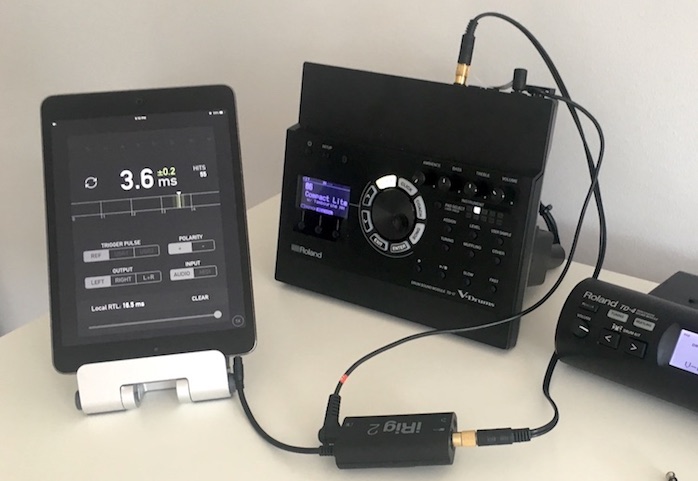
Electronic drum (e-drum) latency is defined as the time delay between the moment a drum pad is hit and when a sound is produced by the system. Latency is measured in milliseconds.
The speed of sound in air is approximately one foot per millisecond (ms). For a drummer, this means that an acoustic kick drum would have a "natural" latency of about 3 ms and an acoustic snare drum about 2 ms (as it is closer to the drummer's ears). Someone playing guitar 6 feet away from the amp would experience at least a 6 ms delay.
The human brain is able to deal with small amounts of latency. It adapts to the different situations and performs "natural" latency compensation. Latency of 10 ms or less is usually considered acceptable. Latency of 15 ms or more is noticeable by most people and starts to become an issue, especially for live playing.
A typical e-drum setup includes drum pads/trigger as input, an electronic drum module/brain for converting the input to sound, and an audio output (headphones or PA). The drum pad/trigger impact signal is detected by the module that then sends a pre-recorded or synthetic audio sample to the output.
A more advanced edrum setup would incorporate a MIDI or USB connection to a PC running a DAW with a VST instrument. There the drum module acts only as a trigger interface to detect hits, routing the information to the PC where the VST produces the actual sound.
Latency can occur on several points:
Jitter is defined as the amount of variation in the e-drum latency. Due to the unpredictable nature of jitter, compensation can be challenging. This is why it is sometimes considered even more important than latency.
Latency can be measured in several ways. Drum pad output can be split and a two-channel oscilloscope used to display the trigger signal on one channel and the sound output on the other channel.
Another option involves recording trigger input and sound output on separate tracks in an audio processor software, then calculating the time difference (as samples or milliseconds).
These methods are time-consuming and error-prone, due to the lack of single measurement accuracy and the need for manually calculating the time difference. Not to mention the whole procedure has to be repeated every time a trigger setting is adjusted or buffer size changed.

EDLM iPhone app was developed specifically for measuring latency in electronic drums. The app uses an audio interface to connect to the input and output points of an edrum system and provides automated and accurate latency measurements.
The EDLM app sends a trigger pulse to the module while simultaneously recording and waiting for the drum sound to arrive. It then calculates and stores the time difference between the two moments. This cycle is continuously repeated at different intervals as the accumulated data is used to estimate the average latency and jitter amounts.

The app requires an audio interface and a loopback cable. Any iOS compatible audio interface will work as long as it provides input and output.
Calibration is the process of determining the Local Round Trip Latency (RTL) of the audio interface. The Local RTL is subtracted from all measurements to get the latency of the drum module under test. This is crucial for obtaining accurate results.
The Local RTL varies by audio interface, so it must be recalculated every time a different interface is used. iOS updates may affect RTL as well, so be sure to recalibrate after an update.
The system is now calibrated and ready for use. The Local RTL value is saved in the app until recalibration. Tap the "CLEAR" button whenever you need to recalibrate.
The EDLM app detects drum sound transients to measure latency. For best results choose a clean sound with a sharp attack and quick decay, for example, a tight snare with little room or reverb effects.
At this stage, the edrum latency meter app should be displaying results. The average latency is shown in white and the jitter (deviation) in green. A graphical representation is also available. Wait for a couple of hundred measurements for reliable readout. Tap the "REFRESH" button every time you adjust a setting on the drum module. This will restart the measurement cycle.
If a red waveform is shown in the hit flow monitor and no stable results are displayed, try the following: Decrease input gain on the interface and/or output volume on the module. Use line out on the module instead of headphone out. Turn off any room/reverb effects. Choose a shorter drum sound sample.
With a couple of tweaks latency can often be reduced, especially for PC/VST setups. Check the Reducing E-Drum Latency article for more information.
Measured latency depends on factors such as the attack of the chosen drum sound, the input and output levels, and the audio adapter used. Results may vary slightly, usually within 0.5 ms. This will not affect jitter (as it is a relative value).
The minimum latency that can be reliably measured is 2 ms. This represents the length of the trigger pulse. Values below 2 ms may result from audio bleeding between the input and output.
The reference trigger pulse is designed to stimulate the drum module as quickly as possible - it is an idealized waveform with a sharp attack and short duration. Large drum pads and acoustic triggers may need more time until the hit vibrations reach sufficient amplitude, adding up to 1 ms of latency compared to synthetic measurements. Check the Drum Pad Clone article for more information.